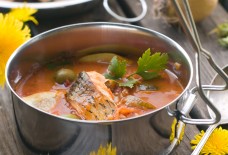A Bejeweled Bulgur Pilaf with Pomegranate Molasses and Black Garlic Dressing
By: Blanche Shaheen/Arab America Contributing Writer
When looking for new recipe ideas, the biggest inspiration can come from the actual ingredients in the Middle Eastern kitchen. Some fresh herbs like mint clipped from a windowsill herb garden, a bag of ripe pomegranates from the farmer’s market, some bulgur grain in the pantry, or an exotic condiment like pomegranate molasses can all feed exciting new dishes. I had these exact ingredients on hand one winter afternoon, which inspired the recipe for this hearty Bulgur Wheat Pilaf. Making wheat into bulgur is an ancient process that originated in the Mediterranean region and has been an integral part of Middle Eastern cuisine for thousands of years. Arab civilizations record eating dried cooked wheat as early as 1,000 B.C.
For people with small means, bulgur was an excellent food that could be stored for long periods of time and was filling and nutritious. As people from the Middle East migrated to the United States, bulgur came with them. There are 4 distinct sizes of bulgur, and for this recipe, I prefer #4, which is the largest sized grain. Bulgur has a nutty flavor and chewy texture that absorbs seasoning very well, as well as offering a good dose of iron, folate, magnesium, protein, and fiber.
This particular salad, which can be considered a pilaf, is like a bowl of jewels, made colorful with sparkling pomegranate seeds, parsley, mint, pistachios, and sultanas, or golden raisins. The flavors and textures are at once chewy, crunchy, nutty, sweet, and savory. You can serve this dish all year round: in the summer as part of a picnic (as the salad can be eaten at room temperature and is not perishable) as part of a holiday feast (the green and red in the salad add a festive touch) and as a quick side dish any day of the week. Pomegranate seeds are available all year round in large markets, and you can also keep a supply of pistachios in your freezer ready to use for any last minute recipe. The dressing is simple yet robust because of the pomegranate molasses, which is at once sweet, rich, and tart. The black garlic adds a luxurious touch, but you can use garlic paste or powder if you don’t have black garlic. Black garlic has hints of caramel, with no pungency so you can add it to any dish without cooking it first. To see the technique of how to make this salad, click on the video below:
Ingredients:
1 cup bulgur #4 (largest variety)
1 tbsp butter
1 Shallot minced
1 ½ cup broth (either chicken or vegetable)
1 tsp cumin
1 tbsp tomato paste
¼ cup Pomegranate seeds
1/2 cup parsley, chopped
¼ cup fresh mint, chopped
¼ cup feta cheese, crumbled
¼ cup sultanas (or you can use any other dried fruit you like)
¼ cup shelled, roasted, and salted pistachios
½ cup garbanzo beans (canned)
Salt and pepper to taste
Dressing
1 large bulb black garlic (or 1 tsp garlic powder)
1 tbsp pomegranate molasses
2 tbsp extra virgin olive oil
Heat butter in a saucepan, and add shallots. Saute until translucent. Add the bulgur wheat and incorporate with the shallots. Add the tomato paste, cumin, about ½ tsp salt and broth, and bring up the heat so the mixture could boil. Once boiling, reduce heat and cover, cooking for 20 minutes or according to package directions (finer bulgur wheat requires less time to cook). In the meantime, prepare the dressing. In a small food processor, add the black garlic (or garlic powder) along with the pomegranate molasses and olive oil. Whirl together. Once the bulgur is cooked, let cool until lukewarm temperature. Add the rest of the ingredients to the bulgur (from the pomegranate seeds to the garbanzo beans). Drizzle the pomegranate molasses dressing over the bulgur mixture and toss gently to combine. Season with salt and pepper to taste.
Blanche Shaheen is a journalist, food writer, and host of the cooking show called Feast in the Middle East. She specializes in Arab cuisine of the Levant and beyond. You can check out her cooking video tutorials and cultural commentary on growing up Arab American at https://www.youtube.com/user/blanchetv Her recipes can also be found at https://feastinthemiddleeast.wordpress.com/



